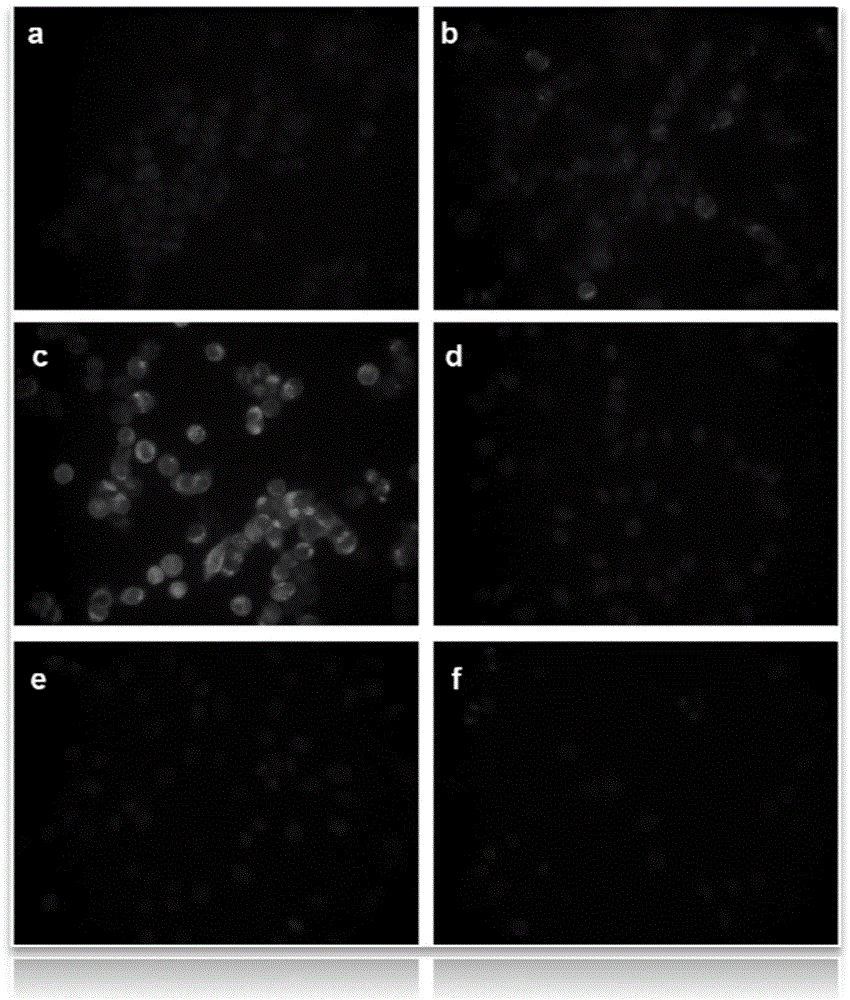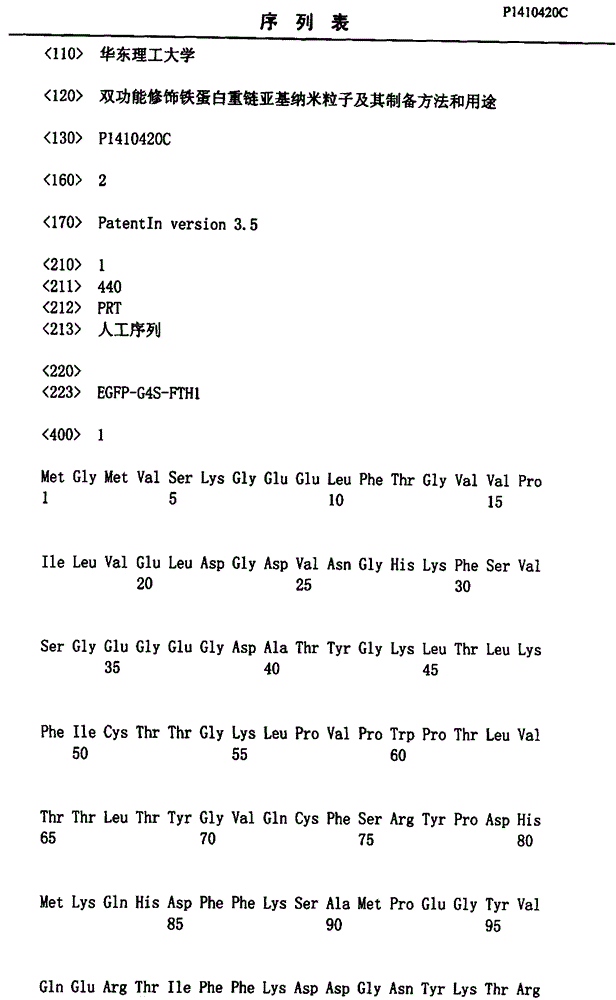Difunctional modified ferritin heavy chain subunit nanoparticles as well as preparation method and application thereof
A ferritin heavy chain and nanoparticle technology, applied in the field of biomedical engineering, can solve the problems of single function, inconvenient observation and analysis, and insufficient traceability.
- Summary
- Abstract
- Description
- Claims
- Application Information
AI Technical Summary
Problems solved by technology
Method used
Image
Examples
Embodiment 1
[0046] Example 1 Expression of EGFP-G4S-FTH1 and EGF-FTH1 fusion protein
[0047] 1. Use overlapping PCR technology to amplify the hEGF::FTH1 gene, insert the fragments into pET28a(+) vector, and transform into DH5αt competent cells, then transform the expression vector with the correct sequence into Ecoli.BL21(DE3) ) Expression strains to obtain target engineering bacteria. The amino acid sequence of the EGF-FTH1 target protein is shown in SEQ ID NO.2.
[0048] For the preparation and washing of EGF-FTH1 inclusion bodies, please refer to the 2011 Li Xu graduation thesis of the School of Bioengineering, East China University of Science and Technology, "Preparation of Functionalized Heavy Chain Subunit Ferritin Nanoparticles and Research on Breast Cancer Cell Targeting".
[0049] 2. Using overlapping PCR technology to amplify the gene of EGFP-G4S-FTH1, insert the fragment into pET28a(+) vector, and transform it into DH5α competent cells, then transform the expression vector with the ...
Embodiment 2
[0051] Example 2 Preparation of hybrid nanoparticles EGF-FTH1 / EGFP-G4S-FTH1
[0052] 1. Degeneration of inclusion bodies
[0053] Add 25ml of Buffer C to the relatively pure inclusion bodies, ultrasonically resuspend until no particles are visible to the naked eye, and denature overnight at a constant temperature oscillator at 28°C. After filtering with a 0.22μm filter, SDS-PAGE was performed to detect the purity of the target protein after denaturation. Two denatured proteins were obtained: EGFP-G4S-FTH1 and EGF-FTH1.
[0054] 2. Refolding: Refolding of inclusion bodies by gradient dialysis. First handle the dialysis bag: take the dialysis bag, boil it in Buffer D for 10 minutes, rinse it with double distilled water, boil it in Buffer E for 10 minutes, cool it, and keep it at 4°C for use. Mix the denatured EGFP-G4S-FTH1 and EGF-FTH1 at a molar ratio of 4:6, the volume is 50ml, and the total protein mass is 5mg. After mixing, put them into the pretreated dialysis bag, and seal the ...
Embodiment 3
[0062] Example 3 Study on cell targeting of FTH1 / EGFP-G4S-FTH1 hybrid protein nanoparticles
[0063] (1) Trypsinize MDA-MB-468 cells to 2×10 5 The concentration of each cell in each well is plated in a 24-well cell culture plate that has been added to the cell slide. After the cells are mixed, 37℃, 5% CO 2 Incubate overnight in an incubator to allow the cells to adhere.
[0064] (2) After cells adhere to the wall, wash 3 times with 1×PBS buffer, add 0μM, 0.02μM, 0.1μM EGF-FTH1 / EGFP-G4S-FTH1 nanoparticles, and add 10μM EGF to a cell sample and incubate for 3 hours .
[0065] (3) After the incubation is completed, wash with 1×PBS buffer for 3 times to wash away the nanoparticles that have not been internalized into the cells, and then add 4% paraformaldehyde to fix the cells at room temperature for 5 minutes.
[0066] (4) Wash the cells 3 times with 1×PBS buffer to remove residual paraformaldehyde solution, 200ng / mL DAPI, 200μL per well, DAPI solution is prepared with 1×PBS solution. I...
PUM
 Login to View More
Login to View More Abstract
Description
Claims
Application Information
 Login to View More
Login to View More - Generate Ideas
- Intellectual Property
- Life Sciences
- Materials
- Tech Scout
- Unparalleled Data Quality
- Higher Quality Content
- 60% Fewer Hallucinations
Browse by: Latest US Patents, China's latest patents, Technical Efficacy Thesaurus, Application Domain, Technology Topic, Popular Technical Reports.
© 2025 PatSnap. All rights reserved.Legal|Privacy policy|Modern Slavery Act Transparency Statement|Sitemap|About US| Contact US: help@patsnap.com



